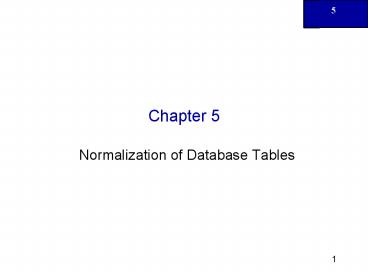Normalization of Database Tables PowerPoint PPT Presentation
1 / 17
Title: Normalization of Database Tables
1
Chapter 5
- Normalization of Database Tables
2
In this chapter, you will learn
- What normalization is and what role it plays in
the database design process - About the normal forms 1NF, 2NF, 3NF
- How normal forms can be transformed from lower
normal forms to higher normal forms - That normalization and ER modeling are used
concurrently to produce a good database design - That some situations require denormalization to
generate information efficiently
3
Database Tables and Normalization
- Normalization
- Process for evaluating and correcting table
structures to minimize data redundancies - Reduces data anomalies
- Works through a series of stages called normal
forms - First normal form (1NF)
- Second normal form (2NF)
- Third normal form (3NF)
4
Database Tables and Normalization (continued)
- Normalization (continued)
- 2NF is better than 1NF 3NF is better than 2NF
- For most business database design purposes, 3NF
is as high as we need to go in normalization
process - Highest level of normalization is not always most
desirable
5
The Need for Normalization
- Example Company that manages building projects
- Charges its clients by billing hours spent on
each contract - Hourly billing rate is dependent on employees
position - Periodically, report is generated that contains
information displayed in Table 5.1
6
The Need for Normalization (continued)
7
The Need for Normalization (continued)
- Structure of data set in Figure 5.1 does not
handle data very well - The table structure appears to work report
generated with ease - Unfortunately, report may yield different results
depending on what data anomaly has occurred
8
The Normalization Process
- Each table represents a single subject
- No data item will be unnecessarily stored in more
than one table - All attributes in a table are dependent on the
primary key
9
The Normalization Process (continued)
10
NF Definitions
- 1NF A table is in 1NF if it has a primary key
and it has no multi-valued attributes. - 2NF A table is in 2NF if it is in 1NF and it
has no partial dependencies. - 3NF A table is in 3NF if it is in 2NF and it
has no transitive dependencies. (When a non-key
attribute depends on another non-key attribute,
it is called a transitive dependency.) - STUDENT (Student-ID, Student-Name,
Student-Phone) - Key attribute Non-key
attributes
11
Examples of Tables Not in 1NF
- STUDENT(Student-ID, Student-Name, Class-Code,
Grade) - QUESTION What normal form is the above table in?
- ANSWER It is not normalized at all (or it is in
0NF) because It has multi-valued attributes
Given one student ID, Class-Code and Grade are
multi-valued.
12
Examples of Tables Not in 2NF
- ENROLLMENT(Student-ID, Class-Code, Class-Title,
Grade) - QUESTION What normal form is the above table in?
- ANSWER It is in 1NFbecause (1) It has no
multi-valued attributes. (2) However, it has
partial dependency, i.e., Class-Title depends on
Class-Code only, which is part of the key.
13
Examples of Tables Not in 3NF
- CLASS (Class-Code, Class-Title, Instructor-ID,
Instructor-Name) - QUESTION What normal form is the above table in?
- ANSWER It is in 2NFbecause (1) It has no
multi-valued attributes. (2) It has no partial
dependencies. (3) However, it has a transitive
dependency since Instructor-Name depends on
Instructor-ID.
14
Examples of Tables Not in 3NF
- ENROLLMENT (Class-Code, Student-ID, Grade)
- QUESTION What normal form is the above table in?
- ANSWER It is in 3NFbecause (1) It has no
multi-valued attributes. (2) It has no partial
dependencies. (3) It has no transitive
dependencies.
15
A Simplified Process of Converting Tables to 3NF
- Identify all functional dependencies, i.e.,
identify determinants and their dependent fields. - Create tables such that every determinant becomes
the PK of the table and the dependent fields
become other columns of the same table.
16
A Simplified Process of Converting Tables to 3NF
- EXAMPLE
- PROJECT(Project, Project-Name, Employee-ID,
Employee-Name, Employee-Project-Hours) - Step 1 - Identify Functional Dependencies
- Project ? Project_Name
- Employee-ID ? Employee-Name
- Employee-ID, Project ? Employee-Project-Hours
17
A Simplified Process of Converting Tables to 3NF
- EXAMPLE
- PROJECT(Project, Project-Name, Employee-ID,
Employee-Name, Employee-Project-Hours) - Step 2 - Define Tables
- PROJECT (Project, Project_Name)
- EMPLOYEE (Employee-ID, Employee-Name)
- PROJECT_ASSIGNMENT(Employee-ID, Project,
Employee-Project-Hours)

